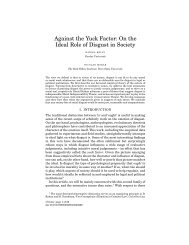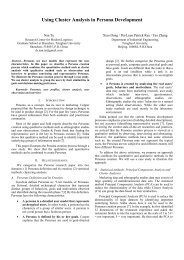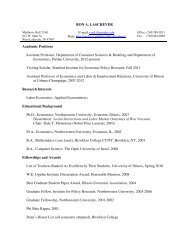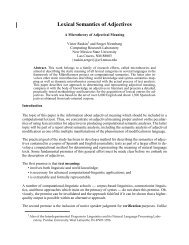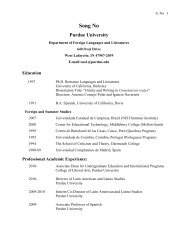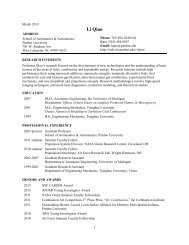The Dopamine Hypothesis of Schizophrenia: An Historical and ...
The Dopamine Hypothesis of Schizophrenia: An Historical and ...
The Dopamine Hypothesis of Schizophrenia: An Historical and ...
Create successful ePaper yourself
Turn your PDF publications into a flip-book with our unique Google optimized e-Paper software.
Kendler <strong>and</strong> Schaffner / <strong>Dopamine</strong> <strong>Hypothesis</strong> <strong>of</strong> <strong>Schizophrenia</strong> ■ 55<br />
lacking—a viable alternative theory against which<br />
the DHS has had to compete. Thus, one potential<br />
lesson from Kuhn for the DHS is a negative one:<br />
it persisted because no sufficiently prominent <strong>and</strong><br />
more successful alternative theory ever developed,<br />
in t<strong>and</strong>em with which the burgeoning empirical<br />
anomalies <strong>of</strong> the DHS could generate a true crisis<br />
leading to a subsequent revolution. At present,<br />
there is still no consensus on an alternative theory<br />
to the DHS, although most speculation seems to<br />
focus on multi-neurotransmitter neurocircuitry,<br />
in which glutamate may play a prominent role<br />
(Harrison <strong>and</strong> Weinberger 2005).<br />
Imre Lakatos<br />
In an attempt to synergize Popper’s falsifiability<br />
approach with Kuhnian insights, Lakatos<br />
(1970) developed what he termed “a methodology<br />
<strong>of</strong> research programs.” Research programs,<br />
he suggested, typically responded to problems <strong>of</strong><br />
falsifying experiments, not with wholesale rejection<br />
<strong>of</strong> their theory, but rather with modifications<br />
<strong>of</strong> its peripheral elements, leaving intact what he<br />
called its “hard core.” Furthermore, in contrast<br />
with Kuhn, Lakatos suggested that proponents <strong>of</strong><br />
different programs could communicate with each<br />
other <strong>and</strong> assess the relative strengths <strong>of</strong> different<br />
“programs.”<br />
Lakatos was particularly interested in distinguishing<br />
two kinds <strong>of</strong> programs. Progressive<br />
research programs confronted difficult empirical<br />
facts, explained them using their theories, <strong>and</strong> generated<br />
novel predictions that were subsequently<br />
empirically confirmed. Einstein’s theory <strong>of</strong> general<br />
relativity is an exemplar <strong>of</strong> a progressive research<br />
program. It predicted the unexpected “bending”<br />
<strong>of</strong> light around the sun observed by Eddington in<br />
1919 <strong>and</strong> continues to be verified by increasingly<br />
accurate physical measures <strong>of</strong> our universe (Bennett<br />
2005).<br />
By contrast, degenerating research programs<br />
confront empirical difficulties with ad hoc alterations<br />
to their hypotheses that explain the individual<br />
anomaly, but do not account for new facts.<br />
A classical example <strong>of</strong> a degenerating research<br />
program is the Ptolemaic astronomic system<br />
that, when confronted with increasingly accurate<br />
measures <strong>of</strong> planetary motion, simply added more<br />
epicycles.<br />
Which <strong>of</strong> these systems does the DHS most<br />
closely resemble? <strong>The</strong> DHS did generate a few<br />
novel findings such as the association between<br />
schizophrenia <strong>and</strong> the Cys311Ser polymorphism<br />
in the D2 gene. However, this result must be set<br />
against the many failed predictions <strong>of</strong> the theory,<br />
many <strong>of</strong> which were accompanied by post hoc<br />
rationalizations about the source <strong>of</strong> the failure.<br />
Although the picture is mixed, in general, the DHS<br />
has more closely resembled a degenerating than a<br />
progressive research program.<br />
Bayesian Approaches<br />
One difficulty with Lakatos’s vision <strong>of</strong> scientific<br />
progress is the lack <strong>of</strong> both a general measure to<br />
assess how well a program is faring <strong>and</strong> a system<br />
by which to determine how experimental successes<br />
or failures incrementally impact on the validity<br />
<strong>of</strong> an underlying theory. Several philosophers<br />
<strong>of</strong> science have developed an approach to these<br />
problems utilizing a Bayesian model <strong>of</strong> scientific<br />
reasoning (Dorling 1979; Howson <strong>and</strong> Urbach<br />
2005; Schaffner 1993).<br />
From a Bayesian perspective, the DHS began<br />
as a theory with a reasonable prior probability <strong>of</strong><br />
being true. <strong>The</strong> relationship between DA blockade<br />
<strong>and</strong> antipsychotic drug action had been well<br />
supported <strong>and</strong> consistent evidence indicated that<br />
DA agonist drugs could produce psychotic-like<br />
pictures. A Bayesian model allows each new experiment<br />
to impact on the posterior probability<br />
that a theory is true. A verification <strong>of</strong> the predictions<br />
<strong>of</strong> the theory makes it more likely to be true.<br />
A failure <strong>of</strong> verification makes it less likely to be<br />
true. <strong>The</strong> size <strong>of</strong> the change in this probability<br />
relates to the quality <strong>of</strong> the test. <strong>The</strong> better the<br />
test, the bigger is the change in either direction.<br />
So, when Eddington showed that light from a<br />
distant star was really bent when it passed by the<br />
sun, this had a big impact on the probability that<br />
Einstein’s theory <strong>of</strong> general relatively was true.<br />
It was a powerful test <strong>and</strong> the prediction <strong>of</strong> the<br />
theory was validated.<br />
How has the DHS fared from a Bayesian viewpoint?<br />
It has had many tests, most <strong>of</strong> them <strong>of</strong> only<br />
modest quality. However, a high proportion <strong>of</strong><br />
them were disconfirming—the prediction <strong>of</strong> the<br />
DHS was not verified. <strong>The</strong>refore, in aggregate,<br />
although the DHS started with a reasonable prior



